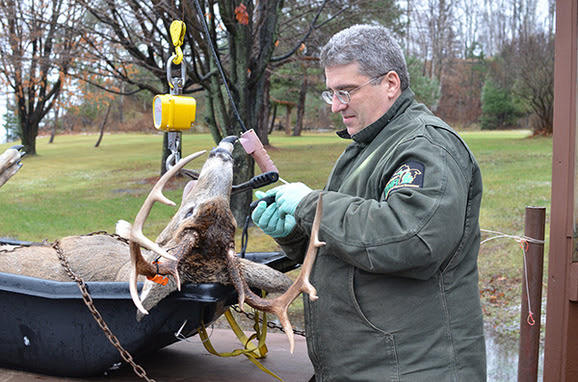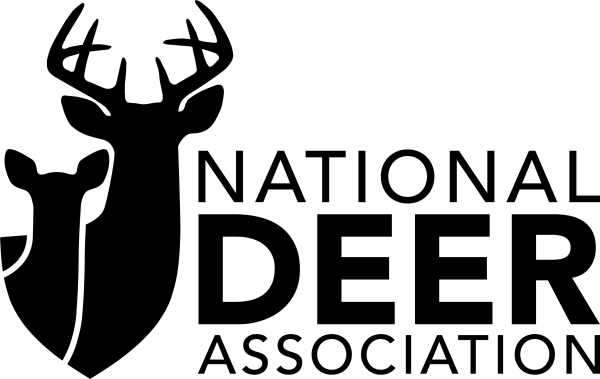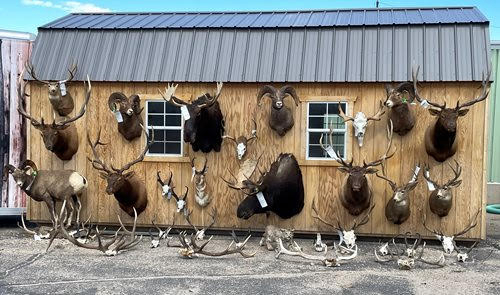The aging process: How and why deer are aged at DNR check stations

Whether for fun or to better judge preferable animals to target, many hunters have an interest in the ability to age white-tailed deer, whether on the hoof or in hand.
Attempting to determine the age of a deer while it is in the field is a matter of observing a range of physical characteristics based on various age classes. There are numerous resources available online and elsewhere to help hunters learn how to become proficient at doing this.
Each fall, as successful hunters bring their deer in to be registered at Michigan Department of Natural Resources check stations across the state, many of these men and women watch carefully as DNR wildlife technicians and biologists age deer based on characteristics of the animal’s teeth.
The DNR uses the age of harvested animals — not exclusively deer — to model species age structure with the intent to better manage wildlife.

Furbearers, such as black bears and bobcats, are aged by removing a tooth and sectioning the tooth to count the layers of cementum, which is a specific part of each tooth that is deposited annually.
Like the rings of a tree, annual cementum deposits may be counted to determine the age of the tooth and, by extension, the age of the animal.
Any animal may be aged in this manner, including deer, but instead, the DNR ages deer and elk according to tooth replacement and wear. Though not as accurate as sectioning a tooth and counting the layers of cementum, assessing tooth replacement and wear is a more time-efficient method.
Employing this faster aging method is appropriate given the high number of deer kills registered in Michigan each year. Last year, for example, the DNR registered a total of 39,220 deer from 86 check stations.
The premise of the method
As many people know, fawns are born during the spring and early summer (late May through mid-June). Therefore, during the autumn deer hunting seasons, the new fawn crop is about six months old.
All individual animals in this age class, or cohort, show similar tooth replacement and wear. Given the consistent one-year gap between each year’s fawn crop, each deer age class should have similar tooth wear and other dental characteristics.
This premise is the basis for aging deer using this method.
Tooth replacement and wear
DNR check station personnel examine the teeth on the lower jaw, or mandible. A deer’s top teeth have similar wear characteristics, but the bottom teeth are often easier to view.
Most mammals have deciduous teeth, commonly called baby teeth. Permanent (adult) teeth replace the deciduous teeth and are added as the animal matures.
Fawns, at six months old, are easy to identify because they only have four cheek teeth, unlike adults, which have six cheek teeth.
Cheek teeth refer to the premolars and molars and can be best viewed in a deer by cutting the cheek and opening the mouth. This practice is most helpful in aging older deer.

DNR check station staffers ask permission from hunters before cutting the cheek of their deer.
1-year-old deer
Deer 18 months old, called 1-year-old deer for short, have six cheek teeth. All adult deer have six cheek teeth.
So, the next step is to look at the third premolar, which is the third cheek tooth from the front of the jaw. In most 1-year-old deer, this tooth is a tricuspid (a tooth with three points or cusps), which is meaningful because a tricuspid third premolar is a baby tooth.
At about 18 months of age, this tooth is replaced by a bicuspid (a tooth with two cusps or points) adult tooth — easily distinguishable from the tricuspid baby tooth. Some 1-year-old deer have replaced this tooth with a bicuspid adult premolar.
At this age, the overall condition of all the lower teeth is sharp, with little wear and little staining.
2-year-old deer
Deer that are 2 years old have six cheek teeth — just like a 1-year-old deer — and a bicuspid adult third premolar, but the overall condition of the teeth shows more indications of wear.

Specifically, look at the cusp farthest back in the mouth of the deer. A 2-year-old deer will have a cusp that is slightly flat on top. A 1-year-old deer will have a back cusp that is barely worn, with a pointed tip, if it is protruding through the gum line at all.
Adult deer have what appear to be “longer” faces than fawns. As a deer grows, its jaw lengthens, expanding the opportunity for more teeth to fit comfortably within the mouth.
As this happens, the back teeth begin to grow and protrude from the gum line, exposing them to wear and tear from food. For this reason, in adult deer, it is helpful to assess the condition of wear of the back teeth — these teeth are relatively new.
This technique is easier to use to accurately age a deer than by examining the first molar. However, despite this key role the back cusp plays in aging a deer, caution must be used.
The overall condition of the teeth – tooth staining, and sharpness, for examples – is a useful aging tool as well. This is a skill not easily taught but learned throughout the course of looking at many deer.
3-year-old deer
Deer that are 3 years old can be identified by looking at back cusp on the back molar too. These deer will have a “dished” appearance on this cusp. A tooth in such condition is worn down, more prominently exposing the brownish inner portion of the tooth, which is called dentine.

The outer white-colored enamel is much harder than the dentine. Being softer, dentine wears faster than enamel. This difference in hardness results in different wear rates, creating the “dishing” of the back-most cusp as the outer enamel wears away slower than the dentine.
Overall, the cutting surfaces of the cheek teeth are duller in 3-year-old deer than in 2- and 1-year-old deer.
Those trying to age deer in this manner should be aware that enamel can be stained dark brown with age depending on the deer’s food source. Typically, brown-stained enamel is found at the gum line, as opposed to the brownish dentine found near the cutting surfaces of the teeth.
This is another useful aging tool. Older deer generally have more staining of the tooth enamel, but this characteristic may vary widely.
4-year-old deer
Deer that are 4 years old and older are more difficult to age than younger deer. They lack the more distinguishable characteristics used to decisively age a younger deer.
Successive years of wear generally result in teeth that are worn down to the gum line by age 10. Someone attempting to age these deer will have to try to extrapolate what level of wear the teeth show compared to 3-year-old deer and 10-year-old deer. This is easier said than done.






